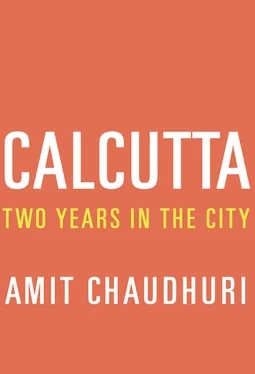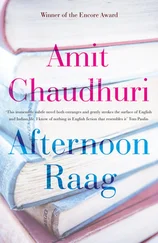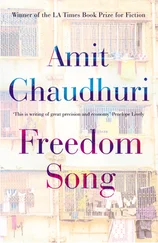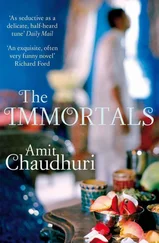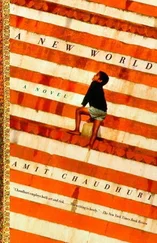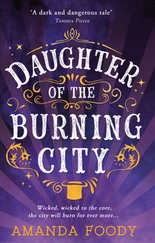The Calcutta upper class was also all related to each other: I realised this after I moved here. More exclusive than the Jews, less endangered, they seemed to know each other by name, and, if they didn’t, had the knack — or helpless habit — of unearthing connections. They might have once married outside their immediate circle: into a bhadralok or educated middle-class family, for instance. (The word “bhadralok” is admittedly slightly slippery; since it’s synonymous with “gentleman,” it could well be claimed by any member of the landed gentry or even the suited Ingabanga clan who wished to be part of the new dispensation that came into being by the end of the nineteenth century, of secular individuals identified by their sophistication and learning, rather than the extent of their property and land.) Whatever the nature of these marriages, it’s true that my family (East Bengali landlords on my father’s side, who lost their properties with Partition; colonial engineers on my mother’s side, who lost face and status after her father’s early death) could hardly claim to be part of this web of relations in Calcutta.
My wife herself is a product of a series of marriages that travelled, confusingly, in several directions. Her mother was a daughter of a manager of a Tata factory in Jamshedpur, outside Calcutta. Naturally, the family had bhadralok ambitions, and my mother-in-law had talent — which is why she went to Santiniketan to study Tagorean dance. Not long after, my father-in-law, an engineer, fell in love with this undeniably beautiful woman. In proposing to her, he was departing his small, charmed, stifling circle; but he was too besotted to bother — besides, he was in secret rebellion against his parents: the distinguished father and the high-nosed mother. His father, Satish Ranjan Khastgir, was of a Brahmo bhadralok family, a noted physicist, a colleague of the great Satyen Bose, and a D.Sc. from Edinburgh. The painter Sudhir Khastgir was Satish Ranjan’s younger brother.
My father-in-law’s mother, Anila, came from one of the most accomplished Ingabanga families in Bengal; her grandfather was P. K. Ray, the first Indian principal of what was then surely India’s premier institution of higher education, Presidency College; her grandmother, Sarala Ray, founded the Gokhale School. Anila’s grand-uncle, Satish Ranjan, had founded the intimidatingly renowned Doon School.
When I met R, this personal lineage — not that she was overly aware of it — had all but dissolved into the everyday. It was now available in anecdote, transitorily. By the time I married R, her father had retired from a public sector job in Hindustan Copper. Still, she couldn’t entirely escape her past: this was apparent from the way she thought she heard her grandmother speaking the first time she heard Samirda’s mother, and was startled by her narrow, anachronistic vowels.
R’s grandmother Anila — echoed belatedly, and unwittingly, by Mrs. Mukherjee — hadn’t been wholly happy marrying a dhuti-wearing physicist. Her sights had been set on, and imagination fired by, the celebrated Bengali physicist Prasanta Mahalanobis. But the shy man in the dhuti, bespectacled, serious, had been invited to the house to meet the middle sister, herself a studious, reticent type. While leaving the house, he noticed a young woman seated on the staircase behind the banister, giggling. He asked her parents for her hand, leaving, in effect, the older sister forever single — or, as they called such women at the time, a spinster. My wife was close, I think, to her grandfather, and to the sister who was spurned by him in favour of Anila. When I was getting to know R, I discovered she still dreamed of her Mejo thakuma and her dadu.
What Anila Khastgir née Bose really felt about her marriage to the physics professor in lieu of the legendary Prasanta Mahalanobis is difficult to tell from the stories she told my wife — and no one else. Certainly, Satish Ranjan Khastgir earned the devotion of his students, and his granddaughter’s affection, but not the sort of national eminence that Mahalanobis or Satyen Bose did. After retiring from his post as Khaira Professor of Physics at Calcutta University, he and his wife withdrew to the pastoral of Santiniketan, which was, by then, in the late sixties, just beginning to go to seed. Anila survived her husband, who, despite being a teetotaller, died of a mysterious liver disease; and R remembers an incident from a weekend when her grandmother came to visit them in their flat in Mandeville Gardens in South Calcutta. A man who lived in a neighbouring street, Suren Thakore Road, unexpectedly called on the family, asking if he could talk to her. He had spotted her on her arrival, he said; he used to live near the big house in Dhaka where her father, a barrister, was once posted, and he and his brothers would climb up a wall and watch, unobserved, as the two sisters played tennis with their English friends. Anila Khastgir was amused, but, after the man’s departure, she confessed to being a bit down-hearted — that so little remained of that girlhood, and also of the barrier defining it, which had, all those years ago, made that act of spying necessary.
It was difficult for me, at first, to understand the significance of these special Calcutta families, with their past careers, and their often unexceptional present-day representatives. I began to realise that there were a fair number of them around. Many of the worthy people in Calcutta’s upper-class history had never quite reached my consciousness when I was growing up, and if they did — say, the founder of this or that school — they remained at a great distance which I didn’t feel any impulse to cover. Similarly, the Mukherjees: I had no curiosity about their forebears, but kept going back, primarily, for Anitadi’s incomparable sandwiches.
These were made of an ordinary but soft sandwich bread which Anitadi bought from the “market”; she never used the posh Calcutta Club loaf which was evidently good for morning toast but not for the teatime sandwich. They had canonical fillings — chicken and mayo, egg, cheese, and tomato — but, on occasion, Anitadi would give us the idiosyncratic, very personal yoghurt and chives, or add spring onion to the cheese. Even when it was just egg, the sandwich had the capacity to surprise us. It was as if it possessed some of the irreducible ingredient that made the Mukherjees what they were. I could never bear to eat the sandwiches — except in interrupted stretches — because, otherwise, they were gone as soon as they’d arrived. They were perfect to look at, spotless rectangles, but — a fact hidden till you tasted them — quite unresistant; a mouthful announced itself to your palate and then immediately melted to a residue. There were other attractions on the plate, usually expensive high-calorie tarts or a mousse from the nearby Kookie Jar, all meant to convey a surplus of a very un-Bengali well-being. Never, for example, were we served the traditional Bengali teatime meal: the deceptively light, puffy, deep-fried luchis with aubergine or potatoes. That sort of tea would have engendered its own over-familiar universe, its protagonists and rooms, the home of the bhadralok — but not Samirda’s and Anitadi’s world, with its silently paired sandwiches and the still life of the Kookie Jar cakes.
* * *
Mrs. Mukherjee sat upon her chair in the ground-floor flat in Lower Circular Road, almost meditating, except for the wicked, abstracted look the squint gave her, and the inward smile. She ruled the tea from the margins, like a person who wields an obscure power but holds no office. Going in and out of the room, Anitadi would bend to take a query, clarify something, laugh at what the older woman had said.
It had not always been so harmonious. When Samir Mukherjee got polio in 1959, Mrs. Mukherjee had been certain that her son should never marry. No woman would look after him properly, or be patient enough: the marriage would be a disappointment for her son.
Читать дальше
